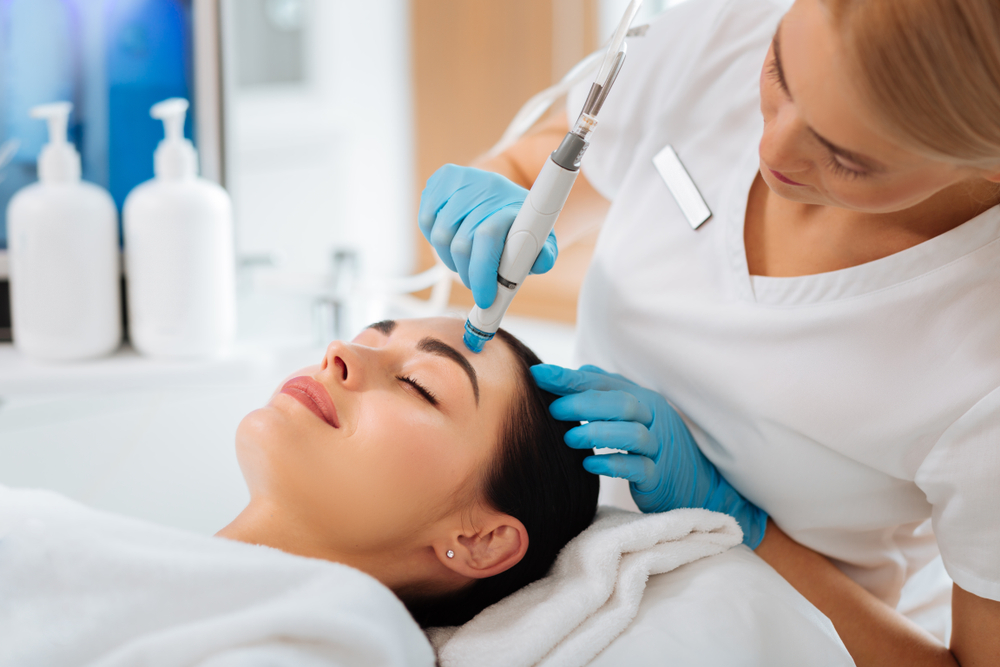Dr. Lee Colony In: Hydrafacial

Skin takes a beating over a lifetime– from free radicals, pollution, and the weather, to name a few culprits. Youthful, healthy skin is an asset in every area of life, but it can be a challenge to acquire and maintain. There are a lot of effective skincare treatments available, but Hydrafacial is one treatment to know about. If you’ve been looking at other procedures, then it can be helpful to have a comparison to some of the popular options available. Here’s a guide to how the Hydrafacial measures up.
HydraFacial Explained
HydraFacial MD uses patented technology to improve and eliminate a variety of skin conditions with a series of quick and easy treatments:
- Hyperpigmentation
- Liver spots
- Clogged pores
- Acne
- Enlarged pores
- Wrinkles and fine lines
- Excess oil
The process of skin rejuvenation is four-fold. First, the skin is cleansed and exfoliated using a spiral applicator and antioxidant. Next, a solution of low-concentration glycolic and salicylic acid further exfoliates the skin and removes oil and debris from the pores. Third, gentle vacuum suction extracts the loosened debris. Finally, antioxidants and peptides are applied to the skin. These help to recondition the skin and remove wrinkles.
This is a safe and non-irritating treatment, the results of which are immediately visible. While there may be slight redness and tightness immediately afterwards, these subside within the day, leaving radiant, clear skin.
HydraFacial and Microabrasion
Microabrasion utilizes a device with either a very fine crystal or diamond tip that works to “sand” or exfoliate the skin to remove the thick, rough layer and leave behind soft and smooth skin. This step is followed by serum infusion while your skin can more effectively absorb active ingredients to preserve the results. In fact, HydraFacial and microabrasion perform the same tasks, though the former includes vacuum technology to extract clogged pores.
…and Microneedling
Wounds in the skin’s outermost layer stimulates the production of collagen. This is the basis for microneedling, which creates tiny channels all over the skin using a pen-like handpiece or roller. This is called collagen induction therapy (CIT). Microneedling has shown to be one of the most effective options for scarring from acne because it can boost cell turnover. Often, microneedling is paired with active ingredients because the wounds generated in the skin mean it can more effectively absorb products into the deeper layers.
…and Chemical Peels
Nothing makes skin look better than exfoliating dead skin cells. Although the Hydrafacial includes a light chemical peel, some patients can benefit from more targeted or deeper chemical peel options. Chemical peels exfoliate the skin using mild acids that can remove dead skin cells and debris, leaving the skin radiant and clear.
…and IPL
Also called Photorejuvenation, Intense Pulsed Light (IPL) also known as Broad Band Light (BBL), uses light energy pulses to cause pigmentation and blood vessels to break down, as well as the production of collagen. Unlike other laser treatments, it doesn’t irritate the skin. The treated cells will slough off in the days following treatment, although you might require multiple treatments to address deep-seated pigment. IPL is one of the best options for pigmentation like redness or rosacea.
Schedule a Consultation
Hydrafacial is a cost-effective option at between $150 and $300 per session. To consult on your options and begin planning your skincare treatment package, contact Michigan Plastic Surgery™ to meet with Dr. Colony and discuss your options.
Meet Dr. Lee H. Colony, M.D., F.A.C.S., a renowned Board Certified plastic surgeon known for his expertise in aesthetic plastic surgery. As a respected national speaker and educator, his dedication to patient safety and involvement in esteemed medical societies highlight his exceptional skills.
